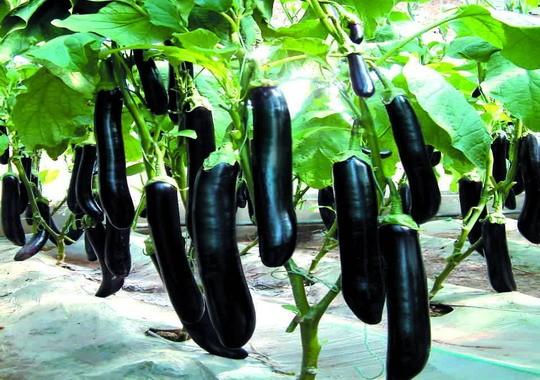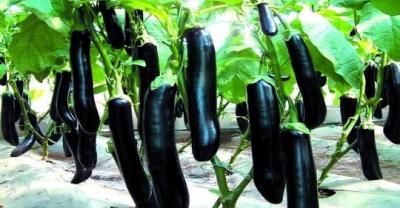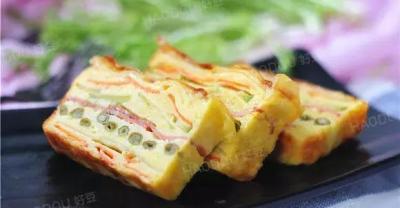Cultivation and Management of Brita eggplant, a Special vegetable introduced from the Netherlands
Cultivation and Management of Brita eggplant, a Special vegetable introduced from the Netherlands
Britta eggplant is a new variety introduced from Holland. The height of the plant is 2 ~ 3m, which is like an "eggplant tree" and can bear fruit by climbing and branching like a cucumber. It has medium-sized leaves, purple flowers, small calyx, long fruit, purple-black fruit, smooth and oily texture, 22 ~ 35cm in length and 4 ~ 7cm in diameter. This kind of eggplant has good disease resistance, high yield, storage resistance and good marketability.
Britta eggplant is suitable for overwintering cultivation in solar greenhouse with multi-layer mulch. In the process of raising seedlings, like other eggplants, the seedlings can also be purchased from the regular seedling base and cultivated directly.
1 site selection
Eggplant is the most avoid repeated cropping. Select the loam or sandy loam that has not planted Solanaceae crops in the previous crop, convenient irrigation and drainage, and deep soil layer. Generally, when the rotten organic fertilizer 5000kg is applied per mu, the total nutrient content of nitrogen, phosphorus and potassium is greater than or equal to 45% of the compound fertilizer 60kg. Fertilizer was applied 15 ~ 20 days before soil preparation and planting. After fertilization, 30cm was turned deeply, leveled and raked fine, and made into small high ridges, ridge height 15 ~ 20cm, ridge distance 80cm.
2 colonization
The planting time is from September 10 to 15, and it should be carried out in the evening of cloudy or sunny day. The distance between plants is 30 ~ 45cm, and there are about 1800 seedlings per mu. Drip irrigation should be used after planting to improve the survival rate.
3Post-planting management
3. 1 temperature management
3. 2 fertilizer and water management
After planting, eggplant was mainly grown in stems and leaves, and watered for 15 ~ 18 days, combined with topdressing, 10 ~ 15kg ammonium sulfate or urea per mu.
3. 3 ploughing
After watering slow seedling water, the soil is cultivated in the middle tillage when the soil is dry and wet, and the depth of middle tillage is about 5cm. Mid-tillage can loosen the soil surface and increase air permeability, which is beneficial to preserve soil moisture, increase soil temperature and promote the development of root system in depth.
3. 4 pest control
It is mainly caused by aphids. Aphids invade the leaves of the plant, causing the plant to grow slowly, curl up the leaves and die. The control of aphids can be controlled with 2000 ~ 3000 times liquid spray of 50% aldicarb per mu, once every 7 ~ 10 days, 2 ~ 3 times continuously, and the control effect is better.
4 flowering stage management
4. 1 pruning and tillering
At this stage, the root of the plant is easy to sprout and tiller, which should be removed in time. In addition, the latent buds under the axils of each leaf were removed to reduce nutrient consumption and improve the ventilation and light transmission conditions of the plant.
4. 2 hanging vines
Britta eggplant plant is tall, need to climb upward with the help of external force, bifurcation results. Hanging vines must be carried out when the plant grows to 70 ~ 80cm, which can not only make rational use of the space, but also prevent eggplant from lodging and causing rotten fruit. Polypropylene tape or rope is often used to tie the eggplant stem and circle it twice, and the other end is fixed on the wire rack.
4. 3 painting
In order to prevent flower and fruit drop caused by low temperature and poor pollination at night, the common concentration is 0. 5%. 02% ~ 0. 0.03% 2B4-D water agent was smeared on the flower stalk 1-2 days before or just after the eggplant blossomed. If you want to put Britta eggplant on the market early, you can add a layer of plastic film after the eggplant blossoms to increase the ground temperature, fertilizer use efficiency and management efficiency in the early fruiting period.
5 initial result period management
5. 1 picking leaves
When the diameter of the door eggplant reached 3 ~ 4cm, the leaves were picked once to remove the withered and yellow old and diseased leaves in the lower part of the plant, so as to improve ventilation and light transmission, reduce flower drop and nutrient consumption, and promote fruit coloring and rapid growth of door eggplant. If the plant grows vigorously, a few more leaves can be removed appropriately.
5. 2 topdressing
When the door eggplant begins to expand, it should be topdressing and watering, applying potassium sulfate compound fertilizer 15kg per mu, once every 10 ~ 15 days.
5. 3 early closing door eggplant
Door eggplant can be harvested 20 ~ 25 days after flowering, at this time, door eggplant is not fully mature, but it should be harvested early, it can be listed in advance, it can also promote the robust growth of plant and the development of upper fruit, and increase the overall yield.
5. 4 temperature management
In the early fruit period, the weather turns cold and the temperature decreases, and the ventilation volume should be reduced step by step. The temperature should be controlled at 20 ~ 28 ℃ in the daytime and no less than 12 ℃ at night.
6. Harvest time management
As the eggplant continues to grow and blossom and bear fruit, eggplant generally enters the peak fruiting period in November. If managed properly, the harvest time of eggplant can be as long as 6 ~ 8 months.
6. 1 fertilizer and water management
In order to make Brita eggplant have a long harvest time and high yield, topdressing and watering should be done at the right time, generally every 7 ~ 10 days, once every 10 ~ 15 days, and applying potassium sulfate compound fertilizer 15kg per mu, which can delay plant senescence, promote fruit growth and ensure the yield in harvest period.
6. 2 temperature management
During the harvest period, Brita eggplant should go through the low temperature season in winter. The temperature should be strictly controlled and the noon temperature should be fully used to increase the temperature in the greenhouse, so that the temperature in the greenhouse should be kept at 25 ~ 30 ℃ in the daytime and 15 ~ 18 ℃ at night. The temperature increased gradually after the middle of March in the second year, and attention should be paid to ventilation and cooling when the greenhouse temperature was higher than 32 ℃.
6. 3 prevention and control of cotton blight
Eggplant fruit cotton blight often occurs in the peak period of eggplant fruit. in the initial stage, the fruit will appear watery spots, gradually expand, produce cotton hairy spot mold, and finally lead to fruit rotting. 75% chlorothalonil wettable powder 600 times liquid spray can be used to control the disease at the initial stage of the disease, once every 5-7 days, 2-3 times continuously.
6. 4 harvest standard
Eggplant is mainly edible tender fruit and should be harvested at the right time. Eggplant harvest reference standard: look at the width of eggplant eye, eggplant eye refers to the connection between eggplant sepals and fruit, the color from white to green band ring.

Cultivation and Management of Brita eggplant, a Special vegetable introduced from the Netherlands
- Prev

Quick breakfast, cheese and vegetable toast, different toast
Sundays are always lazy, especially in winter, the bed always doesn't let me get up, so breakfast is easy and quick to deal with. A few slices of toast, miscellaneous grains and vegetables are enough! ...
- Next

High-yield cultivation techniques of vegetables, so that the harvest of vegetables will be good.
Wen Xuebing Xu, Deng Wenlong. Agriculture and Technology 1 High-yield vegetable cultivation techniques requirements 1.1 soil selection soil quality directly affects the growth of vegetables, so high.
Related
- Where is it suitable to grow horseradish in China? it is expected to see the middle altitude horseradish in Alishan.
- How to prevent tomato virus disease reasonably? (Control methods included)
- Many people like to plant towel gourd on the balcony. What are the main points of this method and management?
- What crops can chili peppers be mixed with?
- Fertilization techniques and matters needing attention in Tomato
- What are the grafting techniques for peach seedlings in spring?
- Harm and control methods of root swelling disease of Chinese cabbage
- What are the pests of sweet potatoes? How to prevent and cure it?
- Symptoms, causes and Control methods of navel Rot in Tomato
- The cause of "Cucumber rotten bibcock" in Farmers' planting Cucumber and its Control Plan

